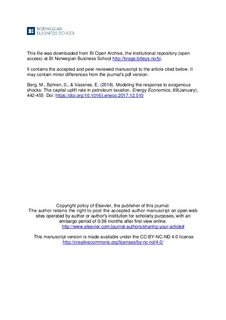| dc.contributor.author | Berg, Magnus | |
| dc.contributor.author | Bøhren, Øyvind | |
| dc.contributor.author | Vassnes, Erik | |
| dc.date.accessioned | 2018-02-09T11:54:28Z | |
| dc.date.available | 2018-02-09T11:54:28Z | |
| dc.date.created | 2018-01-02T08:11:33Z | |
| dc.date.issued | 2018 | |
| dc.identifier.citation | Energy Economics, 2018, 69(January), 442-455 | nb_NO |
| dc.identifier.issn | 0140-9883 | |
| dc.identifier.issn | 1873-6181 | |
| dc.identifier.uri | http://hdl.handle.net/11250/2483706 | |
| dc.description | The accepted and peer reviewed manuscript to the article | nb_NO |
| dc.description.abstract | We show how a recent drop in the Norwegian capital uplift rate by two percentage points changes optimal field design and reduces field value for shareholders. Although optimal design changes considerably and value drops by 12%, the ability to reoptimize design after the shock is worth only 1.5% of field value. This evidence suggests that large behavioral effects of a shock do not necessarily imply large value effects, making it less important to always account for the taxpayers' response. The valuation error in such cases may be moderate if one instead uses the simplifying and widespread assumption of unresponsive taxpayers. | nb_NO |
| dc.language.iso | eng | nb_NO |
| dc.publisher | Elsevier | nb_NO |
| dc.title | Modeling the response to exogenous shocks: The capital uplift rate in petroleum taxation | nb_NO |
| dc.type | Journal article | nb_NO |
| dc.type | Peer reviewed | nb_NO |
| dc.description.version | acceptedVersion | nb_NO |
| dc.source.journal | Energy Economics | nb_NO |
| dc.identifier.doi | https://doi.org/10.1016/j.eneco.2017.12.010 | |
| dc.identifier.cristin | 1533381 | |
| dc.description.localcode | 1, Forfatterversjon | nb_NO |
| cristin.unitcode | 158,1,0,0 | |
| cristin.unitname | Institutt for finans | |
| cristin.ispublished | false | |
| cristin.fulltext | postprint | |
| cristin.qualitycode | 1 | |
